 How does one become an all-powerful witch? In Evenfall, this is determined by the players who can manipulate their tableau the best, allowing them to gain precious points through crafty card play and securing benefits through battle. First-time designer Stefano Di Silvio brings a new hand management and multi-use card game with illustration from artist Martin Mottet. The game is receiving a lot of buzz from high-profile board game content creators. Have they joined the coven of their own free will, or is the proverbial veil stopping them from seeing the truth hidden in the shadows?
How does one become an all-powerful witch? In Evenfall, this is determined by the players who can manipulate their tableau the best, allowing them to gain precious points through crafty card play and securing benefits through battle. First-time designer Stefano Di Silvio brings a new hand management and multi-use card game with illustration from artist Martin Mottet. The game is receiving a lot of buzz from high-profile board game content creators. Have they joined the coven of their own free will, or is the proverbial veil stopping them from seeing the truth hidden in the shadows?
Gameplay Overview:
Evenfall plays from one to four players in about thirty minutes per player. It uses cards to power its actions and has a minor worker placement element included as well. It is ultimately a strategy game with a fantasy veneer. It is played over three rounds, and during each round players take actions from a selection of choices. Round length is indeterminate and continues until all players have passed.
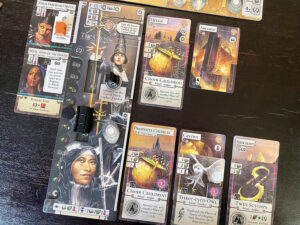
Players begin with starting resources and a hand of cards consisting of specialists and rituals. Specialists provide powerful effects if added to a player’s tableau or may also be added to the council for boosting scoring opportunities. Rituals can only be added to places of power that are gained from visiting regions seeded with these cards. Places of power also provide resource generation with a once-per-round harvest action that adds new items to the inventory for each place of power in a player’s outer circle.
The outer and inner circles are a key concept of the game. Each player’s tableau features an upper and lower section. When players gain a new place of power, it is added to the outer circle. Players can then add rituals to these places of power which may add new worker placement spots, immediate actions, as well as opportunities to enhance the tableau further. The outer circle is for harvesting resources.
The inner circle, or lower section of the tableau, is where cards go to earn points. Certain areas of the game allow you to make this adjustment, and they provide a significant amount of end game scoring. Cards in the inner circle can no longer be harvested for resources, but they do keep their rituals and potential worker placement spots.
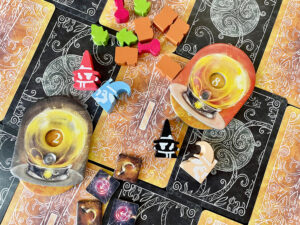
Players have two sets of four workers: witches and elders. The witches can be placed on any of the free action spaces on one of the three main region boards (north, central, and south), or any outer circle worker space. The elder workers can only be placed on worker spaces in the inner circle, unless a card specifically states otherwise. Witches can be used up fast if players seek to add places of power to their tableau, as certain cards require two workers to acquire them.
As players take turns placing workers, playing cards, harvesting, gaining mana, and building catalysts to boost cards, an area control game is unfolding on the region boards. Players must place their witches here to gain places of power, as well as take specific actions available only at specific regions. After all players have passed, a battle takes place at each region based on those players present.
During the battle phase, players use a mana dial to secretly indicate how much they are willing to spend. Each player at the region reveals their dial and whoever has the highest combination of mana and present workers claims a powerstone that boosts inner circle scoring. No matter who wins, all players take the region benefits based on how much they spent. These benefits include resources, card draw, and coven track boosts—player-specific tracks that provide further benefits.
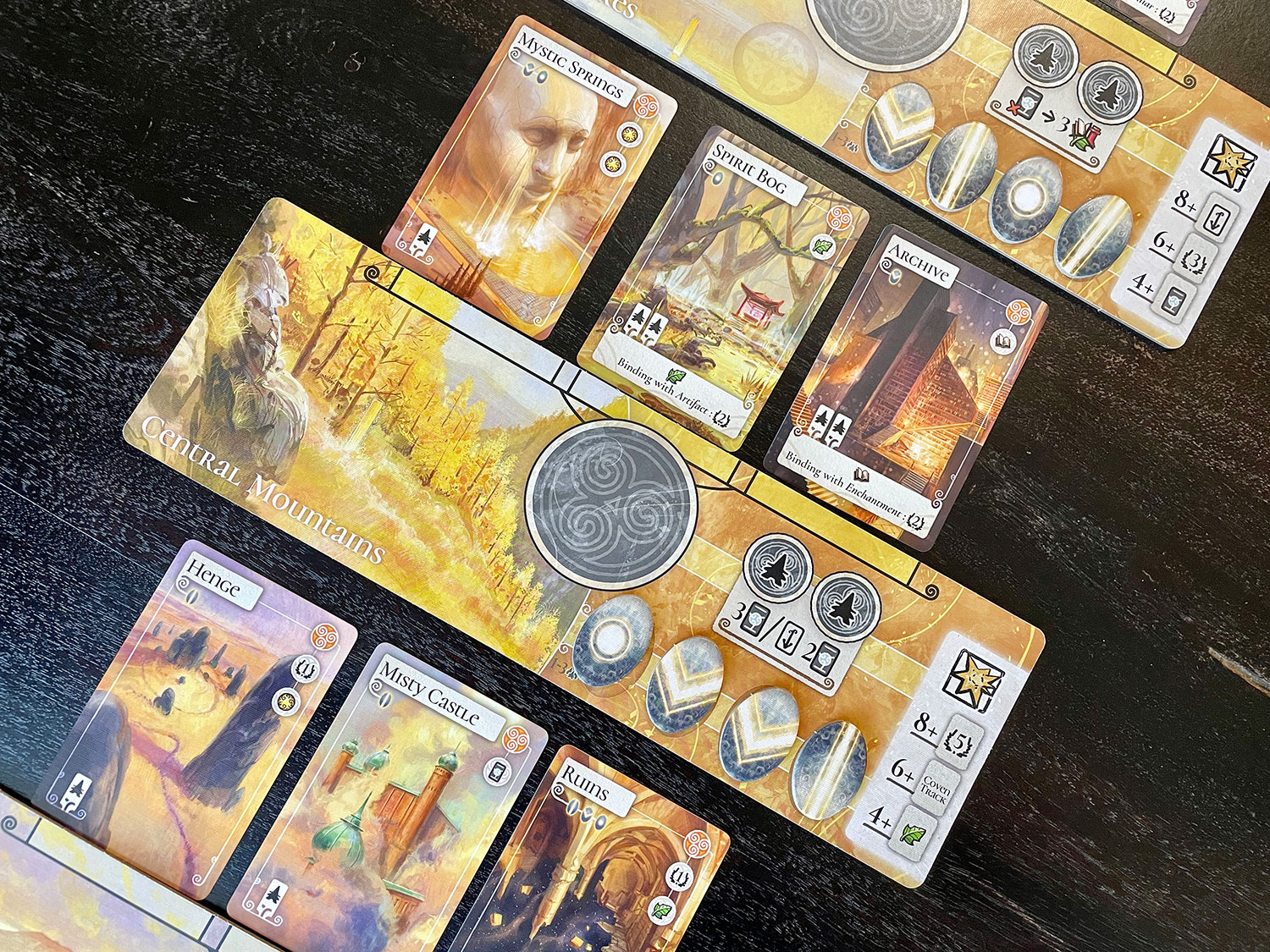
Game Experience:
Evenfall is ultimately a tale of two witches. First off, the outer and inner circle idea provides a lot of interesting decision-making during each round. Players must prioritize how they can efficiently maneuver their cards to allow for maximum harvesting as well as ensuring that points are scored at the end of the game. Not only that, but the elder workers are basically useless until rituals with placement spots begin to spring up in the inner circle.
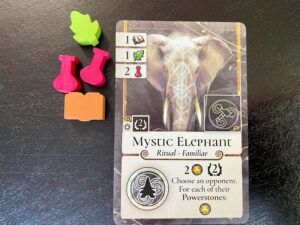
Timing is a key element of the strategy. Certain places of power may gel well with your strategy but may get snatched up by others if you focus on your own tableau for too long. The push and pull of when to play a card or place a worker is a nice element on display. Being able to add personal worker placement spots to a tableau is enticing yet may put a spell on you if you don’t have your order of operations figured out.
The setting here is enhanced greatly by the illustration. Player’s clan boards, the ritual and specialist cards, and even the places of power all add a sense of place. The wooden workers are a nice touch with their thematic hats. Iconography is also very easy to read and understand. This helps keep the game’s pace consistent, though it still overstays its welcome at three and four players.

The multi-use cards are also well implemented here. The specialists can be used in one of three ways, whereas rituals can be used in two different ways. Information is presented well on the card, doesn’t take away from the illustration, and each ritual card also has extra space for the catalyst enhancement (more on this later). High praise can be doled out for the card design in this regard.
This brings us to production. Evenfall is a mixed bag. It has great dual-layered and double-sided clan boards (one side has asymmetric powers), and the resources and workers look great. But then we run into two major gripes that I have. First, the region locations and score track boards. These boards have no reason to be separated. In fact, having a double-sided board (one side for four players) with each region, places for cards, a separate mana track, and scoring around the outside would’ve been perfectly fine. Unfortunately, by foregoing a traditional board, the score and mana tracks are less than ideal.
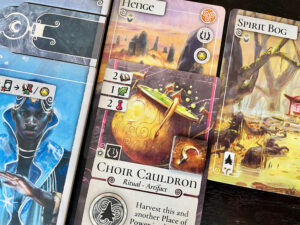
The second is related to setting and card illustration. Rather than enhance the world, place of power cards have too many repeats—I’ve already played enough to find regions seeded with the same location in all spots. It feels like a missed opportunity. There are also doubles of the specialists and the rituals when these could’ve been unique all the way through.
The battle system is also a let-down. While the mana dials evoke the secret dials of Scythe or Dune, the mana track is public knowledge and there are not enough workers to make this an effective battle of the minds. Often you can guess what your opponent will choose. Coupled with the fact that all players gain benefits from the “battle” and the power stone rewards are not that powerful, only doubling points for rituals in the inner circle if they match correctly, leaves the post-action fireworks feel more like a wet sparkler.
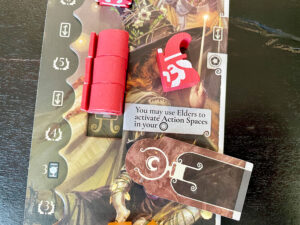
Action choices also don’t feel like they were developed enough. While the worker placement and card play make sense (though region placement is rather boring), it’s the harvest and catalyst options that feel out of place. I’m certain they are there to enhance timing considerations between players, but it never feels good to have to spend a turn gathering resources. Also, the catalyst system, which provides harvest and coven track enhancements, could’ve been integrated into the card play system to allow for a more dynamic decision space.
Final note – the solo automa. This was well-developed and was very easy to use. The automa has several difficulty levels and fights for region control. It can be random at times, but no matter what it is always increasing its score and challenging players to find efficient moves. It plays fast and allows players to get to know each clan’s strategy better.
Final Thoughts:
I’m ultimately left feeling that Evenfall needed more time in development. It has several excellent ideas and wonderful illustrations, both let down by cutting corners on systems and thematic integration. There has also already been an official fix for one of the four clans and their asymmetric board being too powerful which feels like an oversight that feeds into the development woes.
It does feature that excellent outer and inner circle system though. It really is great to dabble with that and weigh the pros and cons of how each place of power benefits you now and into the future. It is tension in the decision space like this that sees the light shine upon the shadowy depths. There is already an expansion on the horizon, and while I’ve not looked closely at its offerings, I do hope that it finds ways to enhance the core gameplay rather than muddy the waters with additional systems.
Final Score: 3 stars – Evenfall’s promise of magic is stifled by a lack of faith in the powerful central system.
 Hits:
Hits:
• Inner/outer circle decisions
• Multi-use cards
• Illustrations enhance setting
Misses:
• Production choices
• Action and battle systems
• Translation misses on clan board and in the rulebook




















